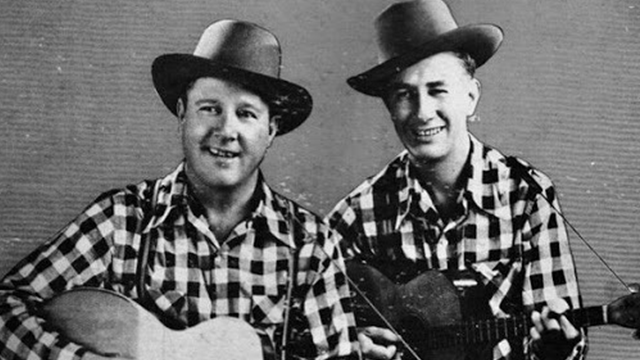
To the casual fan, the Delmore Brothers might be seen as just another duet act from the 1930s, along with the Callahan Brothers, the Monroe Brothers, the Shelton Brothers, the Rice Brothers, or the Bolick Brothers (the Blue Sky Boys). But the Delmores were far more than just another duet act: They were one of the first of these acts, and they retained their popularity longer than any of the others. They sang original songs, and sang them in such a unique musical style that they influenced generations of country and bluegrass performers. Today they are seen as a vital transitional group in country music development; they link the blues, ragtime, and shape-note sacred singing of the rural nineteenth-century South with the polished, complex, media-oriented styles of the 1930s and ’40s. The Delmores are also transitional in another sense, for they were among the first country acts to appeal to a wider audience—they enjoyed two of the first “crossover” hits with “Beautiful Brown Eyes” and “There’s More Pretty Girls Than One.” In their singing you can hear echoes of the Carter Family and Jimmie Rodgers, to be sure; but you can also hear touches of Paul Whiteman’s Rhythm Boys, the early Mills Brothers, and even the Boswell Sisters. The Delmores were wide-ranging in their own musical taste, and their broad-minded creativity helped expand the definition of country music for millions of listeners. Though much of the Delmores’ success came from their own innate skill and drive, part of it also derived from their being in the right place at the right time. In the 1920s it was necessary for the Carter Family or Riley Puckett to generate volume enough to be heard under rather primitive staging conditions, but by 1930 radio had made it possible to sing softly and still be heard. The first generation of country music stars—Rodgers, the Carters, the Skillet Lickers—could not depend on radio to establish their reputations; in many cases their artistic style was not suited to the new radio medium. But the second generation of country stars sensed the absolute need to fit their art to the medium, and the Delmores were among the first of this group. On radio, their carefully crafted harmonies could be appreciated and their strikingly effective lyrics understood. Both Delmore brothers were born in Elkmont, in northern Alabama—Alton on Christmas Day, 1908, Rabon on December 3, 1916. Their parents were tenant farmers who struggled to eke out a living in the region’s rocky red clay, and for much of their lives the brothers saw little but hard times. Musical talent ran in the family; the boys’ mother and uncle were both skilled gospel singers who could read and write music. Uncle Will was a well-known gospel music teacher who had composed and published several hymns. Often, the entire Delmore family would sing at revival meetings and “all-day singings” held at tiny churches throughout the South. As a young boy, Alton was taught to read the old shape-note music by his mother. He also attended various summer singing schools held in rural churches. By the time Rabon was ten, in 1926, the Delmores were playing together and singing the close harmony they later became famous for. They sang informally around the community and at local fiddling contests. Alton admitted later in life that the amateur gospel quartets that flourished (and still flourish) in the rural South were a major influence on their style. The brothers were soon hauling down more than their share of first-place awards in singing, and local newspapers began to praise them in print. Encouraged by this success, Alton began writing to radio stations and record companies asking for a tryout; he got firm but polite refusals. In 1931 they got a chance to cut a single record for Columbia, but it was the depth of the Depression, and it sank like a stone. Alton next approached Harry Stone, manager of Nashville radio station WSM. The station’s Saturday Night Barn Dance, which had been rechristened the Grand Ole Opry only four years earlier, was quickly gaining popularity throughout the South. Alton recalled later: “We all knew that the Grand Ole Opry was the greatest show on the air at the time. Or at least people in the South thought so, and we were southerners.” But for a year Stone wrote back offering little encouragement. The brothers hung on. “We brought home some money nearly every time—precious money that kept some food on the table, along with Daddy’s help. We were treated almost as celebrities at our home in Limestone County, Alabama, but we didn’t have the money to make the thing real.” Finally, in 1932 the boys auditioned successfully for the Opry and were given a regular thirty-minute slot, replacing the Pickard Family. The Delmores’ stay on the Opry was stormy and controversial at times, but it gave them the exposure and the national audience they needed. They became popular with listeners right away. Soon they were receiving more mail than any other Opry performer except Uncle Dave Macon. The brothers actually read their mail, made up lists of numbers that were requested, and even sent personal letters in reply. They had an unusual rapport with their audience, but were disappointed at being unable to get good tour bookings.
